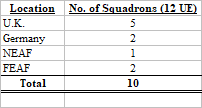RoC,#112. But UK was never "the undoubted lead" in Euro-Aero, "highly-developed industry": that's the myth of Empire of the Skies.
Let's start with the Peace Dividend, 1946, Munitions Industry dismantled, avionics firms back to civil radio: no enemy. UK Aero tried its best, labour oozing away, to do the Brabazon suite of turbine replacements for DC-3, DC-4, L-049. All, bar Viscount....failed.
US and USSR did not know they had no enemy, so a spiral of military spend. We can understand why USSR wondered why US continued to build B-50, B-36 and their Bombs, after VJ-Day, before Berlin Airlift provocation.
So...Korea, 10/50, USSR's puppet invades and kills Brit/ANZ/US et al. WW3 imminent. By Armistice, 6/53 US has put Aero-UK, France back on their feet and has started to create New-Aero-Italy/Japan, 5/55 /FRG - not for their $-renewed production facilities to build Airbus destroyers of US taxpayers' jobs, but to share the cost and cadavers.
Success, so we all move to steady-state vigilant Defence and to civil prosperity. Heavyweight US techno-leads, from Defense Budgets consistently higher than UK's (Japan's never >1%, FRG's >3.1% of GDP), included GW and avionics. A list of US licences taken by UK is long: this thread, for TSR.2 has Verdan Main Computer, but there were more. RAE and NASA exchanged Tech.Papers, 2-way street, e.g.: flap-blowing, much mutual benefit, no "ownership".
Then Ike pre-empted Trump and cut the $, so 801xRAF Canberras, muchly $-Aided, would have become 50xTSR.2.
By then 3/65, France, FRG, Italy in every Aero sector, and Japan in some, could match UK, product by product, box by box, projectile by...and exceeded UK in Space, GenAv...and why on earth not? No-one can do everything.
The glorious past never was; the excellent today is real - in Space, in RR, in MBDA's GW...it's just that UK does not now rollout solo Air Vehicles (bar some UAVs).
We have used up too much bandwidth on this thread on Lightning - a low payload-range, very bespoke disruptor of high-incoming manned platforms, and on snarling at Ministers for keeping Hunters so long: but this was capital-sparing means of doing the Army Co-op which for so long was RAF budget orphan. US had $-Aided F.6 procurement; the FGA.9 mod was within the capacity of RAF MUs where many were done sort-of-doubly-free.
The oft-over-looked feature of Defence Procurement decisions, 1955-60 was demise of conscription; the X-Factor added to military pay scales, to offset uncivil aspects of life; the grotesque cost of ownership of...warmware. It's 7 years right now till RAF will set you free on a Fast Jet; then you might have 3 active tours before you fly a desk awhile; then unsociable you, you intend to draw a pension for with luck 40 years, your better half, half awhile longer. So of course Ministers try to collaborate with a mate so to try to get solo-£100 kit for...something less.


